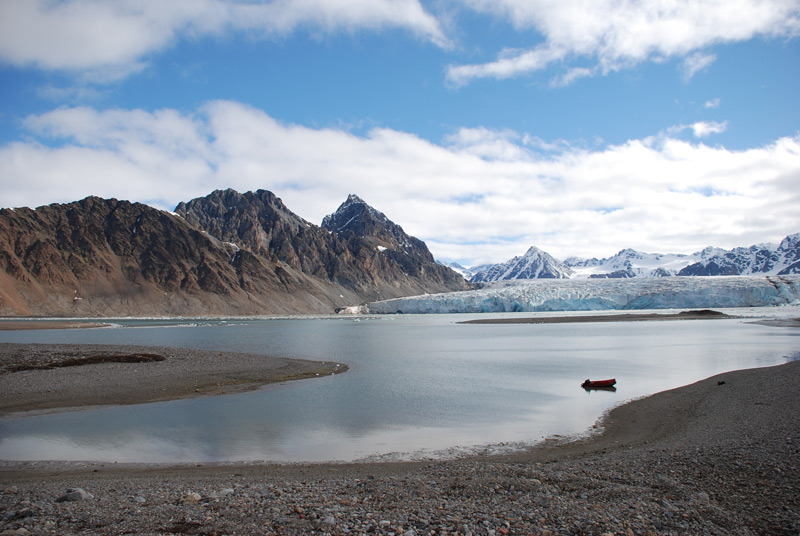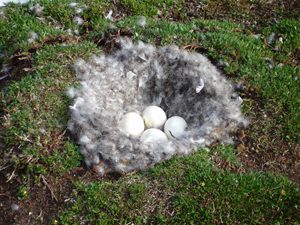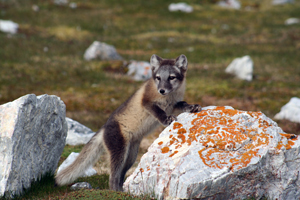Fjortende Julibukta
[79° 07.5' N 11° 52' E]
By Øystein Overrein (ed.), Jørn Henriksen, Bjørn Fossli Johansen, Kristin Prestvold
The bay of Fjortende Julibukta boasts magnificent scenery, a glacier that calves into the sea and a cliff on the north side of the bay teeming with breeding birds. The birdlife is vulnerable and must be respected. Please be considerate during landings and while moving through the area so as not to cause any harm to the birdlife.
 Fjortende Julibukta. (Image: Geir Wing Gabrielsen / The Norwegian Polar Institute) Take care:
- Be considerate towards nesting birds in the area. Do not land prior to 1 August on the north side of the bay, in consideration of the nesting geese. Keep a distance from nesting birds.
- Maintain a fair distance to the fox dens.
 A beautiful summer day at the glacier of Fjortende Juli-breen. (Image: Kit Kovacs & Christian Lydersen / The Norwegian Polar Institute) A beautiful summer day at the glacier of Fjortende Juli-breen. (Image: Kit Kovacs & Christian Lydersen / The Norwegian Polar Institute)
 When pink-footed geese leave their nests, the eggs are exposed to thieves. (Image: Lise Øvrum / The Governor of Svalbard) When pink-footed geese leave their nests, the eggs are exposed to thieves. (Image: Lise Øvrum / The Governor of Svalbard)
 Arctic foxes quickly appear where geese have left the nest. In the summer foxes collect as much food as possible for their winter supply. (Image: Marie Lier) Arctic foxes quickly appear where geese have left the nest. In the summer foxes collect as much food as possible for their winter supply. (Image: Marie Lier)
Inside of Kapp Guissez Krossfjorden opens up to a wide fjord in northern direction. Far into the fjord, the cliff Kongshamaren can be seen at the southern tip of the peninsula of Kong Haakons Halvøy. At the right side lies the plateau of Krossfjordflya, which is an old strandflat. North of the plateau lies the bay of Fjortende Julibukta. The bay is not very long, but the glacier of Fjortende Juli-breen calves into the sea along a three-kilometre-wide glacier front. The glacier is a typical valley glacier with an area of approximately 81 km2. The highest point on the glacier is about 1200 m.a.s.l. The glacier has retreated during the last decades.
At the north side of the bay of Fjortende Julibukta, a steep mountain ridge rises from sea level to a height of almost 1000 m: the Casimir-Périerkammen. Here lies a great bird cliff housing northern fulmar, kittiwake and Brünnich’s guillemot as the dominating species. A considerable number of Atlantic puffins and black guillemots are also found here. Pink-footed geese nest in the slope beneath the bird cliff and outwards on the beach ridge toward the point of Redingerpynten. They are vulnerable to disturbances in June and July prior to egg hatching and during the chicks’ first week. Traffic in the area should be avoided in this period because of the danger of disrupting the nesting birds. Glaucous gulls and Arctic foxes quickly steal the eggs when brooding geese are scared away from their nests. Please also be considerate and careful when walking near the fox dens.
Vulnerable elementsA number of bird species nest in the area, including pink-footed geese, which are extremely vulnerable to disturbances during brooding. Traffic on land in the bay of Fjortende Julibukta prior to hatching of the geese eggs and in the first weeks after hatching can easily lead to increased loss of eggs and chicks. It is therefore advised that tourists not land until after 1 August. Keep a distance to flocks of geese with chicks at sea. Stay away from the Arctic fox dens, and by all means don’t feed curious foxes! Landing sitesThe best place to land is along the northern side of the bay, just outside of the pronounced point. Recommended trailsThere is a good viewpoint on the hill by the headland out toward the sea – see the first picture.
|